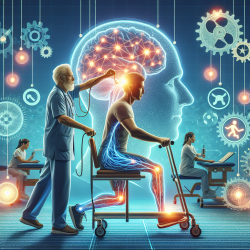Introduction
In the realm of poststroke rehabilitation, understanding the intricate relationship between cognitive and motor functions is crucial. A recent study titled Association of Dual-Task Gait Cost and White Matter Hyperintensity Burden Poststroke: Results From the ONDRI sheds light on this complex interplay. The study highlights the significance of dual-task gait cost (DTC) as an indicator of white matter hyperintensity (WMH) burden, particularly in subcortical regions. This blog explores how practitioners can utilize these findings to enhance their therapeutic approaches and encourages further research in this domain.
Understanding Dual-Task Gait Cost
Dual-task gait cost refers to the decrease in gait performance when a cognitive task is performed simultaneously. This study found a positive association between increased DTC and WMH burden, especially in subcortical regions like the basal ganglia and thalamus. These findings suggest that increased DTC may indicate larger white matter damage, affecting cognitive processing and gait automaticity.
Implications for Practitioners
For practitioners, these insights offer a new perspective on evaluating and treating poststroke patients. Here are some practical steps to integrate these findings into therapy:
- Assessment of Dual-Task Performance: Regularly assess patients' dual-task performance to identify potential cognitive and motor impairments. This can provide a baseline for tracking progress and tailoring interventions.
- Targeted Cognitive Training: Incorporate cognitive tasks that challenge patients' executive functions during gait training. This can help improve cognitive processing and potentially reduce DTC.
- Focus on Subcortical Regions: Develop interventions that specifically target the basal ganglia and thalamus to enhance motor automaticity and cognitive control.
Encouraging Further Research
While this study provides valuable insights, it also opens avenues for further research. Understanding the precise mechanisms linking DTC and WMH burden can lead to more effective therapies. Researchers are encouraged to explore:
- The role of specific cognitive domains (e.g., attention, memory) in mediating the relationship between DTC and WMH.
- The impact of brain atrophy on dual-task performance and its interaction with white matter lesions.
- Longitudinal studies to assess how changes in DTC and WMH burden affect rehabilitation outcomes over time.
Conclusion
The association between dual-task gait cost and white matter hyperintensity burden poststroke offers a promising avenue for enhancing therapeutic strategies. By focusing on cognitive and motor integration, practitioners can better address the complexities of poststroke rehabilitation. As we continue to unravel the intricate connections within the brain, these insights pave the way for more personalized and effective interventions.
To read the original research paper, please follow this link: Association of Dual-Task Gait Cost and White Matter Hyperintensity Burden Poststroke: Results From the ONDRI.










